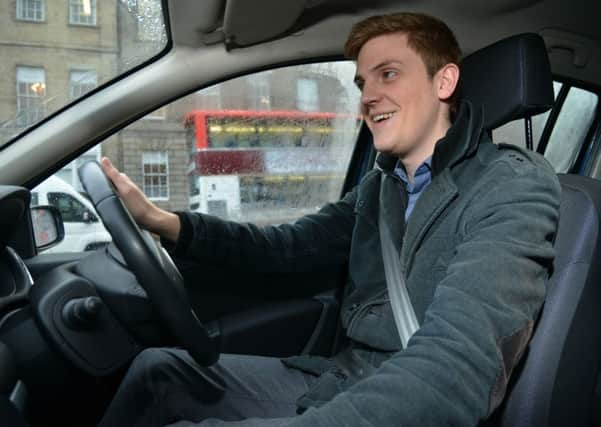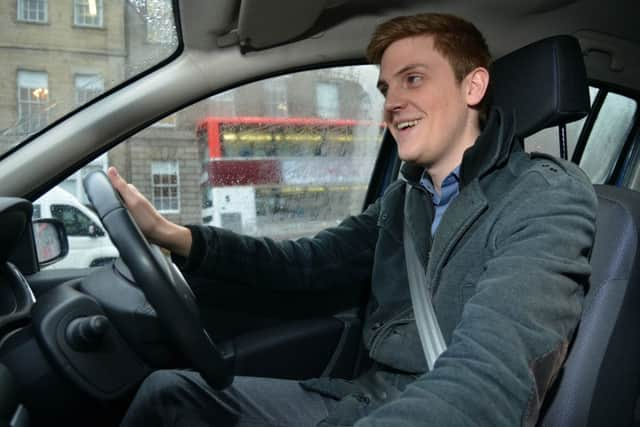20mph test: Little change in journey time, so why?


This time it is not Edinburgh’s maligned tram system that has sent tongues wagging, but a decision to introduce 20mph zones across 80 per cent of the Capital’s roadways.
We decided to put the plans to the test by reducing our speed on a five-mile journey across the city centre.
Advertisement
Hide AdAdvertisement
Hide AdSetting off on a day marred by grey drizzle and sweeping gusts, our route took us from Tynecastle Stadium all the way to Ocean Terminal – cutting a direct path through many of the streets soon to be slapped with speed reductions. From Tynecastle to Dalry Road, we trundled past Shandwick Place and onto Queen Street – before swinging past York Place and down the length of Leith Walk. Our route then led us to the left, along Great Junction Street and into the car park of Ocean Terminal to finish.


And to really get a grip on the effect the council’s proposals could have on drivers, we made sure to do the trip twice – once at 30mph, and then again at 20.
The 20mph speed limit plans for the city centre also includes streets with at least 400 metres of shops and residential routes with high density housing.
Driving at 30mph, our journey took a measured 20 minutes and 32 seconds – taking into account frequent waits at red lights and congested traffic towards the far end of York Place. But it was a smooth trip.
At 20mph, the drive took just three-and-a-half minutes longer – but felt like a lot more.
Other road users clearly thought so, too. On Queen Street, the driver of a silver Vauxhall Astra showed his frustration at our ponderous pace by tailgating for almost the entire length of the road – with a line of cars behind him attempting similar tactics.
And on Leith Walk, some fed-up drivers even took to overtaking as we trudged our way down the one-and-a-half mile stretch.
Both journeys may have come in at similar times, but they proved to be very different experiences.
Advertisement
Hide AdAdvertisement
Hide AdNeil Grieg, director of policy and research at the Institute of Advanced Motorists, insisted our close results reflected the grim reality of driving in the Capital – with most drivers simply unable to reach speeds of more than 20mph due to city streets clogged with traffic.
He said: “What these figures certainly reflect is the reality of driving through Edinburgh these days. Congestion is so high that you never get to the speed limit. It shows that if you do it properly, the 20mph limit is not going to really affect people that much – if it’s done in the right streets and the right places. It’s where it’s done on the wrong streets that people have difficulties.
“People think it’s a huge difference going from 30mph to 20mph – it sounds like a huge difference. But what people don’t understand is that the reality is they have not been going at 30mph in many parts of Edinburgh for years. It’s more a psychological thing – people think it’s a big dip, but it isn’t really.”
He added: “From a driver’s point of view, what this underlines more than anything else is why do we need to be spending more money on changing the speed limit when drivers barely get to 30mph anyway?
“It comes back to our policy on this, which is if you have a street with a problem, then fine – put a 20mph limit on it. But if you put the limit on every road, drivers don’t get the message that particular road is a problem and that they need to slow down.”
And Cameron Buchanan, Tory MSP for the Lothians, said our test run added further fuel to claims the council’s plans were a “waste of money”.
He added: “I spoke to a taxi driver in Corstorphine the other day, and he said the most he can ever get up to is about 28 mph, and never more – and that’s fine. But who is going to enforce this new limit?
“The council is so short of money they are not going to be able to do it. It’s just gesture politics. This about the extra pollution, the cost of bringing it in and enforcing it, and the council’s blanket approach.”
Advertisement
Hide AdAdvertisement
Hide AdCouncil research indicates the new rules will add only 25 seconds to a driver’s journey time for every mile travelled – a full minute shorter than we experienced on our 4.6-mile trip. And last week, the News revealed many speed cameras in proposed 20mph areas cannot be used to enforce the new limit as they are only approved for use by the Home Office for speeds over 30mph.
But Rod King, founder and campaign director for 20s Plenty for Us, insisted the 20mph plans would make Edinburgh a “much more pleasant urban environment”.
He said: “The more you look at this whole issue, the more people realise that actually your journey time is related to how long you are stopped, not how fast you’re going when you are moving.
“There are very few drawbacks for going slower, but many benefits. The more you get detached from the local politics, the more you see that this is what the top-class cities around the world are doing – cities like London, Paris and Copenhagen.”
And councillor Lesley Hinds, the city’s transport leader, admitted she had also put her own proposals to the test – with varying results.
She said: “As a driver, in the past few months I’ve had a go at testing out various regular journeys I make at 20mph and 30mph, to compare the experience. Sometimes I get there quicker at 20mph, sometimes slower – on average, though, I haven’t really noticed much of a difference at all.
“I’m glad to see the Evening News following my example, although I’d be concerned if conclusions were drawn based on only one test as that’s hardly scientific.
“Research in other cities, surveys of current speeds, and results of the pilot project in Edinburgh suggest journey times will not significantly increase.
Advertisement
Hide AdAdvertisement
Hide Ad“We would expect changes not exceeding around 25 seconds per mile, probably significantly lower – around ten seconds per mile has been found in central parts of Bristol where a limit has now been introduced.
“We will be carrying out further research on this matter in Edinburgh and will post the results on the website.”
Trams to be forced to stick to 20mph limit
Trams will be forced to obey 20mph speed limits within the city centre when the controversial new rules come into effect.
Around 80 per cent of the city’s streets are set to be slapped with reduced speeds under radical blueprints given the go-ahead last week.
But city chiefs and tram experts today insisted the change would have no impact on the running of the tram system – adding that timetables would remain the same.
It is understood trams travelling through the city centre rarely exceed speeds of more than 20mph – despite regularly reaching up to 42mph on off-road tracks on the outskirts of the Capital.
Tram expert Professor Lewis Lesley, technical director of light rail company Trampower, insisted the proposals would make “no material difference” to tram operations.
He said: “Of course trams always have to obey the traffic rules – they run on highways and have to behave like any other vehicle.
Advertisement
Hide AdAdvertisement
Hide Ad“They don’t have any special dispensation, when they are running with other traffic; they must obey the same highway rules as the other traffic.
“It’s not unusual. I can’t imagine this is going to make any difference. I imagine on Princes Street you couldn’t go at much more than 20mph now anyway, because of all the pedestrians.
“The only time it might make a difference is at 2am – but I can’t imagine there are very many trams running at 2am, nor are there very many people wanting to use trams at 2am.”
He added: “The short answer is that 20 mph shouldn’t make any material difference to the operation of the trams.”
And city centre Tory councillor Joanna Mowat insisted trams running at a reduced speed had “always been factored in” to council talks over the new limits.
She said: “If you are implementing a 20mph limit, you are doing that for all road-going vehicles in the area – and trams are a road-going vehicle.
“Some people asked questions about this during talks, but as far as I’m aware it was not raised as an issue by Edinburgh Trams. Our concerns are about the scale of the proposals. Where we have roads that are wide and straight, it seems inappropriate because it’s difficult for drivers to keep their speed down. It’s about the scale of the thing being too big.”
Under the proposals, all city centre roads are to be covered by the 20mph limit – as well as streets with at least 400 metres of shops and businesses. Roads with tenements and other high-density housing will also be covered.
Advertisement
Hide AdAdvertisement
Hide AdCouncillor Lesley Hinds insisted trams were bound to the same traffic rules as other road users.
The transport leader said: “Trams will drive to the traffic conditions of the road, whether that is a 30mph or a 20mph speed limit. Edinburgh Trams were involved in our 20mph consultation and confirmed that they were comfortable with what was proposed.” A spokesman for Edinburgh Trams said: “We don’t expect any impact on tram journey times through the city centre following the intro-duction of the 20mph limit.”